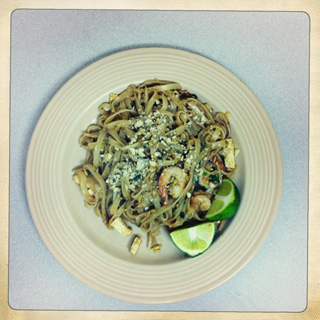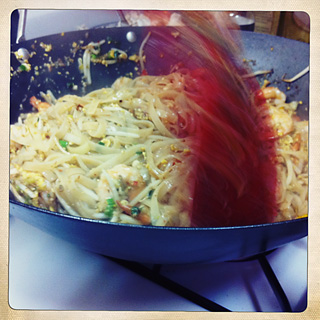The best solution would probably be to get a really nice wok and crank it up high enough to cook food before it's even hit the pan. This sounds untenable mostly owing to the obvious financial burden of such a purchase. Instead, it works pretty well to cook separately those things which normally give our somewhat uncooperative wok a hard time: eggs and tofu.
As far as getting the authentic cheap-but-awesome pad thai flavor I couldn't possibly understate the importance of one particular ingredient: sugar. Really, that seems to be the primary factor. If you piled on twice as much as we use in the recipe below it would probably taste twice as familiar. Shrimp and chicken are possibilities as well, though I would recommend keeping the overall number of shrimp down to limit frustration during consumption. Serving with limes is really a must, and sriracha deserves mention as a worthy condiment.
A shout out to the Nud Pob near BU for getting me hooked on this stuff during undergrad (even though I remain unsure of the pronunciation). Where else could one get a quick mound of noodles if not three doors down at Beijing Cafe. Cities, I miss you.
Pad Thai
Makes Four Servings
20 Minutes Prep, 10 Minutes to Cook
20 Minutes Prep, 10 Minutes to Cook
 The Goods
The Goods- 18 oz. firm tofu, cut into strips and patted dry
- 3 eggs
- 1 bunch scallions, chopped
- 1 cup peanuts, finely chopped
- 12 oz. bean sprouts
- 4 cloves garlic
- 4 tbs. fish sauce
- 2 tbs. rice wine
- 1 heaping tbs. tamarind paste
- Some chili powder, to taste
- 4 tbs. sugar, or more
- 14 oz. rice noodles
- 2 limes
 The Procedure
The Procedure- Completely immerse the rice noodles in the hottest water your faucet can muster. If you don't plan on leaving them soaking for very long, or have some wimpy tap water, consider heating some water up on the stove to supplement. They should be getting soft well before you add them to the pan.
- Cut everything that needs to be cut, chop everything that needs to be chopped.
- Boil a cup of water and add it to the tamarind, stirring until it is mostly dissolved. If using a fresher block of tamarind you will need to break it apart by hand to some extent and let is soak as well. Once the mixture has cooled down a bit you can add the fish sauce, rice wine, sugar, and chili powder.
- In a non-stick pan on medium-high heat, saute the tofu in vegetable oil until golden-brown on all sides. Remove the tofu, add some more oil and scramble the eggs, removing them when done. The rest of the cooking proceeds fairly quickly but is less prone to disaster than trying to keep the tofu together in the wok.
- Put the wok on high heat, add oil and wait until it is shimmering. Make sure the noodles are waiting in their water nearby. Add the scallions and stir-fry for about a minute. Next add the garlic and cook very quickly, maybe 20-30 seconds.
- Making no attempt to thoroughly drain the noodles, move them directly from the water into the pan. Stir until the water is mostly evaporated, then add the sauce and cook for a while longer. After making sure the noodles are appropriately cooked mix in the bean sprouts, peanuts, tofu and egg. If things ever get too dry just add some more water. Add more chili powder to taste. Serve with something grabby, as a spoon is mostly useless. Don't forget the limes!

NB: To cut down on time, chop the peanuts in a food processors or spare coffee grinder.